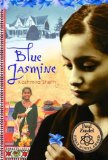
Seema has mixed feelings about leaving her home in India to move to America. While she’s excited for something new, she’s leaving behind her extended family. The move ends up making Seema really think about what she considers necessary for friendship and who she counts as important to her, although this is more evident in the relationships she left behind rather than the new ones she makes.
As usual Kashmira Sheth does an excellent job of explaining unfamiliar vocabulary words and includes a glossary to help students with the foreign words (which I believe are a mix of Gujarati and Hindi?) There’s also a marvelous section where Seema is discovering that even things she knew the English words for go by different names in America. Sheth also does a wonderful job of making Indian life come alive, whether it be the more privileged life Seema leads or the impoverished life of her friend Mukta.
Another thing of note is that Blue Jasmine briefly addresses the use of swastikas both in Indian culture and in America. For those of you who may not be familiar, the word swastika is derived from Sanskrit and in India is generally is a lucky or auspicious symbol. It has significance in Hinduism, Buddhism and Jainism (Jainism is an Indian religion with a focus on non-violence). In America, our primary exposure to this symbol is as the emblem of the Nazis. The difference between Eastern and Western perception of this symbol is significant. It is important for Americans to understand that if they see an Indian using this symbol it may not be representing Nazism.
Overall, this is a fabulous look at one girl’s adjustment to living in America. The only criticism I have is that in one storyline Seema is suffering at the hands of a bully. The bully does some serious reflection and it turns out she’s not really a bad person. I’m always wary of the message this sends to kids. In real life, bullies are very rarely people who will stop and apologize sincerely for their treatment of you. There are so many reasons to read this book though that should not deter you.
I expect that advanced third grade readers could manage this book, but recommend it for grades four and up.
Great for: Teaching similes. Teachers, if you’re looking for a chapter book to show your students how much figurative language can enhance writing, this is it. Kashmira Sheth has peppered the pages of her book with both similes and metaphors. Here are some beautiful examples of her figurative language:
…[T]he stars looked as if someone had scattered mustard seeds across a dark iron skillet.
[S]he…gave me a smile as bright as a thousand-petal chrysanthemum.
[H]er hair was as pretty as silver embroidery on a sari.
Sex, Nudity, Dating – None.
Profanity – “hell” used once.
Death, Violence and Gore – A child is smacked for bad behavior. A child is threatened with a smack for bad behavior. Seema’s mother drops something on her foot and needs to go to the emergency room. A bully pulls Seema’s hair causing her to fall.
Drugs, Alcohol and Smoking – A neighbor explains that dandelions can be made into dandelion wine. Seema refuses to try root beer because she is concerned it really is beer.
Frightening or Intense Things – Seema’s grandmother has a stroke and the family visits her in the hospital. A friend of Seema’s has a relative with tuberculosis. The seriousness of this disease is absolutely clear, and Seema is often afraid of the news from her friend for fear the relative has died. Those of us privileged enough to live in places where tuberculosis has been mostly eradicated are not likely to feel much fear or urgency, but for others this may be a source of worry.

